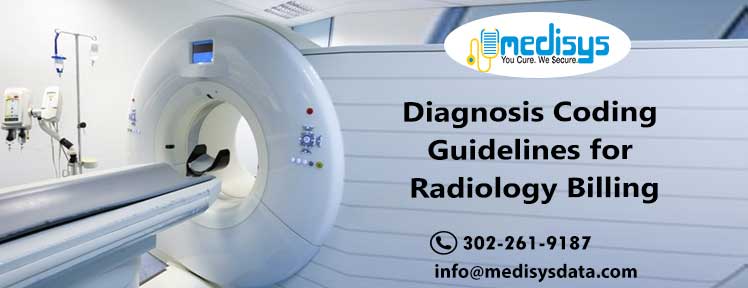Submitting a clean claim and bringing accurate reimbursement for radiology is a challenging task requiring billing and coding expertise. Although many claims are being paid when initially submitted, post-payment reviews by insurance carriers might result in returning the insurance reimbursements. All this can be avoided with proper documentation supporting medical necessity. With radiology services coming under intense scrutiny for medical necessity, it is more important than ever to ensure documentation supporting medical necessity. This includes ensuring that diagnosis coding is done in accordance with the official coding guidelines and the Center for Medicare & Medicare Services (CMS) policy. Following diagnosis coding guidelines will support medical necessity ensuring insurance reimbursements while billing for radiology services.
Diagnostic Test Order
An encounter for radiology services begins with a test order from the referring (ordering physician) which is then taken to an imaging center, hospital, or another provider of diagnostic imaging services. A complete and accurate test order is crucial to coding compliance because payment for services by Medicare is made only for those services that are reasonable and necessary. Furthermore, CMS charges the referring physician with the responsibility of documenting medical necessity as part of the Medicare Conditions of Participation (42 CFR 410.32).
- The Balanced Budget Act of 1997 reiterates the above requirement in Section 4317(b) where it states that the ordering physician must provide signs/symptoms or a reason for performing the test at the time it is ordered. If the referring physician indicates a ‘rule out’, he/she must also include signs/symptoms prompting the exam for ruling out that condition.
- In the event this information is missing, the ordering physician should be contacted for this information before proceeding with the exam.
- Since medical necessity is determined by those signs/symptoms provided by the ordering physician, it is vital to have this information at the time of final coding even when the radiology report identifies an abnormal finding or condition. This information is key in helping to determine whether or not a finding is incidental or related to the presenting signs/symptoms.
- Furthermore, a test ordered to ‘rule out’ a specific condition is considered a screening exam in the eyes of Medicare and would need to be coded as such in the absence of documented signs/symptoms, with a screening code assigned as the primary diagnosis and any findings assigned as additional diagnoses.
Choosing the Primary Diagnosis
As per ICD-10-CM official guidelines, for patients receiving diagnostic services only during an encounter/visit, sequence first the diagnosis, condition, problem, or other reason for encounter/visit shown in the medical record to be chiefly responsible for the outpatient services provided during the encounter/visit. Codes for other diagnoses (e.g., chronic conditions) may be sequenced as additional diagnoses. For encounters for routine laboratory/radiology testing in the absence of any signs, symptoms, or associated diagnosis, assign Z01.89. If routine testing is performed during the same encounter as a test to evaluate a sign, symptom, or diagnosis, it is appropriate to assign both the Z code and the code describing the reason for the non-routine test. For outpatient encounters for diagnostic tests that have been interpreted by a physician, and the final report is available at the time of coding, code any confirmed or definitive diagnosis(es) documented in the interpretation. Do not code related signs and symptoms as additional diagnoses.
Radiology Report
While the test order may determine medical necessity and initially drive the encounter, a review of the final radiology report holds the key to determining the correct diagnosis codes for an encounter. Radiology reports should contain four main sections: clinical indications; technique; summary of findings; and impression and final interpretation. The clinical indications listed on the report should be those signs or symptoms provided by the referring physician that prompted the ordering of the test. The radiologist’s final interpretation, the impression, may list multiple conditions and is the final piece of the puzzle in choosing a primary diagnosis code. Additionally, a careful review of the clinical indications will help determine whether or not certain conditions mentioned in the findings section, or in the impression, are clinically significant or simply incidental findings.
Documentation for Diagnosis Code
At first glance it may appear that diagnosis coding for diagnostic radiology exams is straightforward, it actually can be quite challenging. In many cases, the documentation that must be reviewed prior to assigning a diagnosis code may be unavailable, unclear, or contradictory. There are two key documents for review. Although each is a viable source document for selecting a diagnosis code for the encounter, utilizing only one of these two documents to select procedure and diagnosis codes can result in unnecessary coding compliance risks for any provider of services.
- Test order with accompanying signs/symptoms
- Radiology report containing the final written interpretation
Accurate selection of diagnosis codes and following coding guidelines will ensure steady insurance reimbursements in radiology billing. If you need any assistance in medical billing and coding for radiology billing, we can help. Medisys Data Solutions Inc. is a leading medical billing company that is well versed with billing policies and coding guidelines for radiology billing. To discuss your radiology specific billing requirements, contact us at info@medisysdata.com/ 302-261-9187












